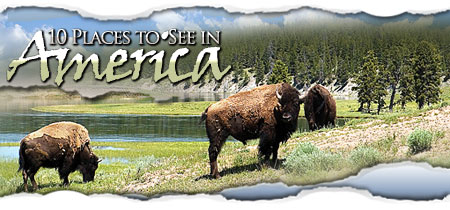
10 Best Places in U.S. for Travel
By
Heather C. Liston
Ask
an adventurous American to name his or her very favorite beauty spots, and chances
are you'll find the subject changed. Once people have found a trail, a mountain,
a geyser, or a canyon that truly moves them, the last thing they want is to have
everybody else rushing out there and blocking the view. The fact is, though, this
country holds an immense variety of natural wonders, and even some of the best-known
ones aren't crowded at all-at least, not once you get out of the car and hike
a mile or so away from the road.
We've
made a purely subjective selection of ten not-to-be-missed American treasures,
so different from one another it's sometimes hard to believe that they're all
on the same continent. Some are surprisingly near major urban areas; others take
some time and effort to get to; but all are more than worth the trip, all still
have room for you, and who knows? You may be so awestruck, you'll actually want
to tell other people about them. |
1. The Badlands, South Dakota
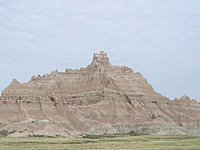 |
|
The
Badlands.
Photo: Rachel L. Miller
|
And
they thought the moon was interesting. Wait until you see the desolate, craggy,
erosion-born eyeful that is the Badlands. Even the name is irresistible. The Lakota
tribe named this area of Southwestern South Dakota "mako sica," which
means "land bad" - but they were probably thinking of how it would work
for farming. If your goal is to feel alone beneath the sky in a dramatic maze
of cliffs, canyons, spires, and buttes, then the Badlands couldn't be better.
The dinosaurs loved it and so will you. The park has eight marked hiking trails,
but all of its 244,000 acres are open to hikers. Just make sure you bring water:
with the world's greatest fossil beds from the Oligocene Epoch, the area has enough
bones. Call (605) 433-5361 for Badlands National Park. [RELATED
STORY]
2. Bayou Country, Louisiana
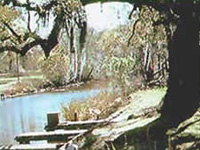 |
Louisiana Bayou |
As
wet as the Badlands are dry, the Bayou country of Southeastern Louisiana is unlike
the rest of the U.S. in so many ways, it will broaden your ideas about the country
you live in. For starters, there's so much wetland that the economy, entertainment,
and transportation system are all built around the water.
Bayou
Lafourche, also known as "the longest 'street' in the world," connects
many of the towns in this area, including Thibodaux, the "Gateway to Bayou
Country." And then there's the local culture: the delightfully spicy food,
the spicy language, and the infectiously lively Cajun music and dancing. The area
offers sugar plantations, shrimp fishing, and boat tours of the swamps, like the
one offered by Zam's of Kraemer, LA, on which you're guaranteed to see live alligators.
You can reach Zam's Swamp Tours at (985) 633-7881, or call (985) 537-5800 for
the Lafourche Parish Tourist Commission. [READ ABOUT ALLIGATOR HUNTING IN THE BAYOU]
3. Giant Redwoods, California
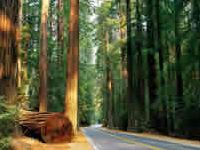 |
California Redwoods |
People
who have walked among the giant redwoods of California never seem to get over
it. Technically known as Sequoia Sempervirens, or coast redwoods, these trees
grow along the California coast, beginning around Big Sur and continuing into
Southern Oregon. Closely related to the Giant Sequoias, which occur in the drier
Sierra Nevada region, the coast redwoods hold the record for tallest trees ever
recorded. You can see them in the Muir Woods National Monument, just a few miles
north of San Francisco, but if you've got time, it's best to travel the Avenue
of the Giants, a thirty-three-mile scenic drive through redwood country from Garberville
up to Fortuna. If you want to hike among the trees, your best bets are Sequoia
Park, located within the town of Eureka, or Redwood National Park at the very
top of California, which includes the Tall Trees Grove, where you'll find the
world's tallest tree, at nearly 366 feet. The Redwood Information Center is at
(707) 464-6101.
4. Mt. Katahdin, Maine
At
5,267 feet, Mt. Katahdin is not one of the highest peaks
this country has to offer, but if you climb it in September
it might feel as though it is...especially if you began
your hike in April. Mt. Katahdin, located in Baxter State
Park in Northern Maine, is the endpoint of the Appalachian
Trail, so it's a place for celebration. This is one spot
you might actually want to visit when it is at its busiest.
Through-hikers usually finish the Georgia-to-Maine odyssey
between August and October, which is also a great time of
year for warmish temperatures and the beginnings of foliage.
Baxter also offers more than 200,000 acres of back-country
camping, fishing, canoeing, and scenic northern forests.
Call Baxter State Park at (207) 723-5140
5. Arches, Utah
Edward
Abbey, the prototype crotchety environmentalist, shot himself in the foot when
he wrote Desert Solitaire, about the peaceful summer he spent in Arches
National Park. "This is the most beautiful place on earth," he wrote,
and then he got mad when we came to see for ourselves. Too bad.
One
of Utah's five knock-your-socks-off National Parks, Arches
has what is possibly the most unusual natural architecture
on the continent. The hundred-plus arches that give the
park its name are the strange and dramatic formations caused
by the weathering of sandstone walls through the ages. Located
next to the town of Moab, (mountain bike capital of the
world), Arches has become very popular in recent years,
and the government - wisely - limits its use. This means,
if you go during high season, getting a campsite in Arches
is about as competitive as getting a seat on the New York
City subway at rush hour. Still, you must see what Abbey
referred to as "The red dust and the burnt cliffs and
the lonely sky-all that which lies beyond the end of the
roads."
The park is open for camping all year, and things slow
down after the first of November. Call the park directly
at (435) 259-8161, or the Moab Area Visitor Information
office at (800) 635-6622
6. Monogahela National Forest, West Virginia
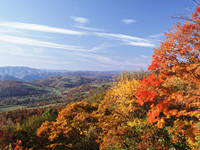 |
Monongahela
National Forest |
John
Denver spread the word a long time ago, "Almost heaven,
West Virginia . . ." But where, exactly? "As far
as I'm concerned, Ma'am, the Monongahela National Forest
is the only place in West Virginia," says Marc Grigsby,
a clerk at the state tourist bureau. The Monongahela (almost
as much fun to say as it is to see) covers 909,000 acres
sprawling across ten counties of West Virginia. It is home
to more than 230 species of birds, 72 species of fish, and
9 federally listed endangered or threatened species (two
birds, two bats, a flying squirrel, a salamander, and three
plants). Vegetation ranges from wild blueberries to cactus,
and the hiking, needless to say, goes on for days. To visit, call the United States Department of Agriculture
at (304) 636-1800 and press "1" to get
to National Forest personnel.
7. Taos, New Mexico
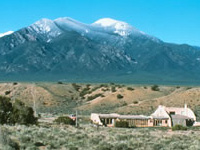 |
Taos
Mountain Stands Guard
Photo by Don Laine |
When
people on the East Coast talk about "historic,"
they mean a couple of hundred years. If you go to Taos,
New Mexico, though, you'll find vibrant evidence of nomads
from 6,000 years ago; of Pueblo Indians from 900 years back;
of Spanish Conquistadors and missionaries from the 1,500's;
of mountain men like Kit Carson who lived here in the early
1,800's; and of some of America's finest artists and writers
(Georgia O'Keeffe, Marsden Hartley, D.H. Lawrence, Willa
Cather) from the last century and a half. All have left
their distinctive marks, but, miraculously, none have interfered
with the serene alpine meadows, the sunny mountaintops of
the high desert, the pristine powder of the nearby ski resorts.
Just seventy-two miles north of Santa Fe, Taos is surrounded
by the Carson National Forest, which offers sunny and varied
Southwestern beauty in every season of the year. Visitor
information is available at (800) 732-TAOS. [READ MORE ABOUT TAOS]
8. Glacier National Park, Montana
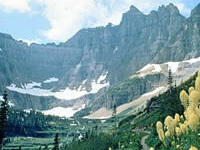 |
Iceberg
Cirque
Photo Source: Glacier National Park |
Located
in Montana, right along the Canadian border, Glacier National
Park offers some of America's most breathtaking wilderness,
with fifty glaciers, 200 lakes, and 1,000 miles of streams.
The peaks of the Continental Divide run right through the
park, making for ups and downs that support a vast variety
of flora and fauna. From the highpoint of Mount Cleveland
(10,448') to the low of the Flathead River (at 3,150'),
Glacier offers a rollercoaster of outdoor thrills. Unlike
most places in the lower forty-eight states, the park has
black bears and grizzlies, as well as gray wolves, mountain
goats, and more than 1,000 species of flowers. For general
Montana visitor information, call (800) 847-4868. Contact Glacier National Park at (406)
888-7800. [ HIKE IN GLACIER NATIONAL PARK]
9. The Berkshires, Massachusetts
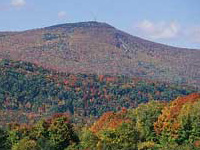 |
Mt.
Greylock
Photo Souce: Massachusetts |
The
Berkshires, in Western Massachusetts, are ideally situated
to offer the best in both wilderness and culture. The area,
though peacefully low in population, still manages to include
Tanglewood, the summer home of the Boston Symphony; Jacob's
Pillow, for the finest in dance; The Mount (historic home
of the novelist Edith Wharton) for one of the great Shakespeare
festivals of the East; the Clark Art Institute for one of
America's fine collections of painting and photography;
and much more. At 3,491 feet, Mount Greylock, near the town
of Adams, is the highpoint of the state in more ways than
one. It's also sufficiently beautiful that Thoreau climbed
it regularly for inspiration. For general information, contact
the Berkshire Visitors Bureau at (800) 237-5747; or for
small-group tours of the wilderness and the culture, call
Greylock Discovery Tours at (413) 637?4442. [SEE FALL FOLIAGE IN THE BERKSHIRES]
10. Yellowstone in Winter, Wyoming, Montana & Idaho
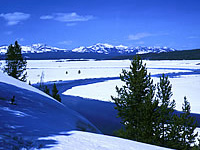 |
Yellowstone
River &
Hayden Valley in Winter
NPS Photo |
"Old
Faithful is not the biggest geyser in the park, or the most
beautiful," a ranger explains. "It just happens
to be one of the most predictable, and it's near the lodge,
so it's all that most people see." But if you come
to Yellowstone, the first of our National Parks, in the
winter, when the usual tourists are home watching TV . .
. and better yet, if you get off the trail and into the
backcountry just a little . . .you will begin to see some
of the most amazing sights of your life.
The
entire area of Yellowstone is a volcano caldera, and the
action throughout the park is constant, varied, and bizarre.
In cold weather, the steaming eruptions of the 10,000 geysers,
natural hot springs, and other hydrothermal wonders are
more visible than ever. Traveling on snowshoes or cross-country
skis, you'll see all that, plus partially frozen waterfalls,
deep in the woods.
The animals will hang out with you, because, hey, it's just
you: it's not all those noisy RV campers who irritate them
all summer. Bison will eye you slowly, as they stand around
in herds, preserving their fat stores to get them
through the winter. Coyotes will circle them, looking for
signs of weakness. Bighorn sheep will gaze down at you from
the mountainsides. Herds of elk, and an occasional moose,
will share your trail to the dining hall in the pre-dawn
glow. Jackrabbits will crouch invisibly by the side of the
trail and then suddenly scram, like bouncing snowballs,
as you approach.
At
the end of the day, you can loll in outdoor hot tubs while
snow drifts lazily at your side and stars wink at you from
above. Wink back: you did the right thing. Call (307) 344-7311
for information and reservations.
[READ MORE ABOUT YELLOWSTONE IN THE WINTER]